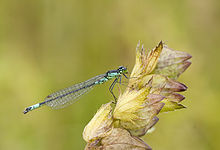Loading AI tools
Species of insect From Wikipedia, the free encyclopedia
The Norfolk damselfly or dark bluet (Coenagrion armatum) is a species of blue damselfly of the family Coenagrionidae native to Eurasia.
| Norfolk damselfly | |
|---|---|
 | |
| Male C. armatum, Sweden. | |
| Scientific classification | |
| Domain: | Eukaryota |
| Kingdom: | Animalia |
| Phylum: | Arthropoda |
| Class: | Insecta |
| Order: | Odonata |
| Suborder: | Zygoptera |
| Family: | Coenagrionidae |
| Genus: | Coenagrion |
| Species: | C. armatum |
| Binomial name | |
| Coenagrion armatum (Charpentier, 1840) | |
This species acquired its common name from its discovery in 1903 and its presence in a very restricted area of the Norfolk Broads, England.
At first glance, this damselfly may resemble a blue-tailed damselfly or a red-eyed damselfly more than a typical Coenagrion species. Both sexes have a distinctive black abdomen with coloured segments at both the base and the tip. Males have very large appendages that distinguish them from similar species.[2]
It breeds in ponds ditches and slow rivers with open helophyte vegetation and good water quality. It is very abundant in Northern and Eastern Europe.
Its breeding biology is poorly known. Eggs are laid in the stems and leaves of aquatic plants. The larvae live among aquatic plants and probably emerge after one year.
It was recorded in Britain from late May to late July. The current populations in Western Europe fly earlier and peak in early May. Males perch on floating leaves. It is a strong-flying damselfly.
It is found from Northern and Eastern Europe eastward to Siberia and Mongolia in Asia. This damselfly was extirpated from its sites in the United Kingdom due to natural succession from open water to dry reedbeds. It was believed to be extirpated from the Netherlands in the 20th century, but was rediscovered there in 1999.
The species was formerly recorded as a breeding species in Britain, in Norfolk. Records came from Sutton, Stalham, and Hickling Broads. It was last recorded in 1968. Since its current main range is from the Baltic area eastward, the likelihood of recolonisation in Britain seems low, and reintroduction may be needed.
Seamless Wikipedia browsing. On steroids.
Every time you click a link to Wikipedia, Wiktionary or Wikiquote in your browser's search results, it will show the modern Wikiwand interface.
Wikiwand extension is a five stars, simple, with minimum permission required to keep your browsing private, safe and transparent.